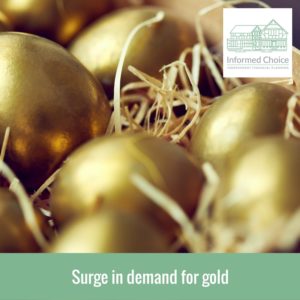 The Bank of England cut in interest rates earlier this month appears to have prompted a surge in demand for gold.
The Bank of England cut in interest rates earlier this month appears to have prompted a surge in demand for gold.
The Royal Mint has reported a 25% increase in transactions on its bullion website during the same week interest rates were cut from 0.5% to 0.25%.
It also saw a 50% increase in demand for gold bars and coins, compared to the previous week.
Year to date, gold has risen in value by 45% in sterling terms since the start of 2016.
In US dollar terms, the price of gold is up by 25% during the same time.
The World Gold Council recently reported that global investment demand for gold has reached a record level during the first six months of the year.
Consumer demand in India and China, where demand for gold is usually the highest, reported lower demand in the first half of the year.
According to Geir Lode, Head of Global Equities at Hermes, the current environment of low rates and economic uncertainty could mean gold as an investment asset class is set to shine.
In a recently published briefing note, Lode explained that historically gold has been seen by investors as a safe haven protecting the downside in a portfolio.
Over the next two to three years, Hermes believe an increased allocation to gold is likely due to macro-economic uncertainty, higher geopolitical risk, and low or even negative interest rates.
Lode pointed out that the US 10 year bond is currently trading at a yield of approximately 1.5 percent and they expect gold to trade higher in an environment with prolonged low interest rates, an outlook supported by the Bank of England’s monetary policy decision in August.
Lode says that even after a strong gold bull market so far in 2016, Hermes thinks that gold is likely to move towards its all-time peak of over 1,800 USD per ounce.
Gold often performs well during times of market volatility, but it is not an investment asset class we specifically allocate to for our clients at Informed Choice.
There are a variety of reasons for this decision, including the lack of income from the asset and the relative difficulty of accessing the investment.
Many investors already have an indirect exposure to gold in their portfolios, with basic materials now representing over 8% of the FTSE 100 index of leading UK company shares.

